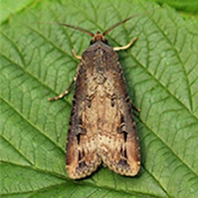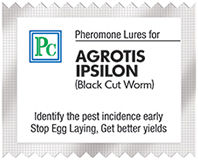
Pheromone Chemicals
Manufacturers of Pheromone Traps & Lures





Agrotis ipsilon
(Black cutworm) – The greasy cutworm, black cutworm is a small noctuid occurring worldwide. The origin of black cutworm is uncertain, though it is now found in many regions of the world, being absent principally from some tropical regions and cold areas. It is more widespread, and damaging, in the northern hemisphere than the southern hemisphere. It annually reinvades temperate areas, overwintering in warmer or subtropical regions. Duration of the life cycle is normally 35 to 60 days. The adult is fairly large in size, with a wingspan of 40 to 55 mm. The adult preoviposition period is about seven to 10 days. Moths select low-growing broadleaf plants preferentially for oviposition. The eggs normally are deposited in clusters on foliage. Females may deposit 1200 to 1900 eggs. Duration of the egg stage is three to six days.
Host Plants
Black cutworm has a wide host range. Nearly all vegetables can be consumed, and this species also feeds on alfalfa, clover, cotton, rice, sorghum, strawberry, sugarbeet, tobacco, Corn and sometimes grains and grasses. In the midwestern. The preference by black cutworm for weeds is sometimes quite pronounced, and crops will be attacked only after the weeds are consumed. Adults feed on nectar from flowers.
Damage
This species occurs frequently in many crops, and is one of the best-known cutworms. Despite the frequency of occurrence, however, it tends not to appear in great abundance, as is known in some other cutworms and armyworms. Black cutworm is not considered to be a climbing cutworm, most of the feeding occurring at soil level. However, larvae will feed aboveground until about the fourth instar. Larvae can consume over 400 sq cm of foliage during their development, but over 80% occurs during the terminal instar, and about 10% in the instar immediately preceding the last. Thus, little foliage loss occurs during the early stages of development. Once the fourth instar is attained, larvae can do considerable damage by severing young plants, and a larva may cut several plants in a single night. Plants tend to outgrow their susceptibility to injury. Corn at the one-leaf stage is very susceptible to damage, but that by the 4 or 5-leaf stage plant yield was not reduced by larval feeding. Leaf feeding and cutting above the soil line are less damaging to corn than cutting at the soil surface. Subterranean damage is very injurious.
ETL for Agrotis ipsilon is 15 – 20 No’s of moths per trap per day.
Use 8-10 No’s Pheromone Traps per acre from 15 days crop stage to control pest at early stage.
Trap canopy should be placed one feet above crop canopy to achieve optimum catch.
Recommended for: Cotton, Paddy, Sorghum, Sugarbeet, Tobacco.
© 2020 Pheromone Chemicals. All Rights Reserved | Powered by: Raviteja Designs